Star Date 7 August 2017 Monday
Captain's Log
Happy Monday! :)
Another Tropical Storm ("Franklin") has flared up but again a short lived event in the Atlantic Basin. It is now a record shattering 4,306 days or 11 years 9.5 months since the last major hurricane hit the U.S. (Cat 3 Wilma 24 Oct 2005 hit Florida)...a 166+ year record drought.
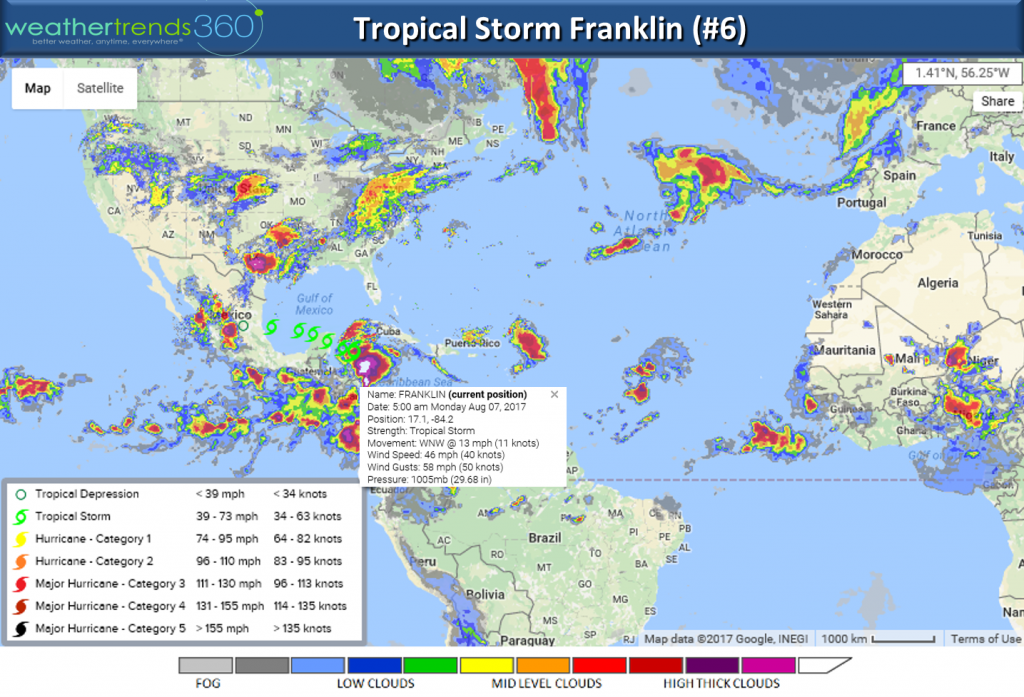
The odds of this was 1 in 2000 according to hurricane experts at Colorado State University. We came close last year with Matthew but it was only a cat 1 at landfall. Fingers cross we go another year but we're bucking the odds and we are entering the peak of the hurricane season - now through late September. CLICK ON IMAGES FOR LARGER VIEW.
They could use some hurricane type rains in the Upper Midwest/Plains as soil moisture levels are very dry. Some areas in the Plains have less than 5% soil moisture which is having a negative impact on crops in the region. Here in the East almost saturated in spots with 35% to 40% soil moisture levels. The absolute max soil moisture level is around 50% in areas like rain forests.

This time last year we were having a severe drought in the Northeast and now this year we're on a record shattering pace for the wettest year on record. Bethlehem PA and Jacksonville FL are just a couple examples of YTD rainfall trends #1 wettest in decades while Sioux City IA and Fargo ND are having driest year in decades.
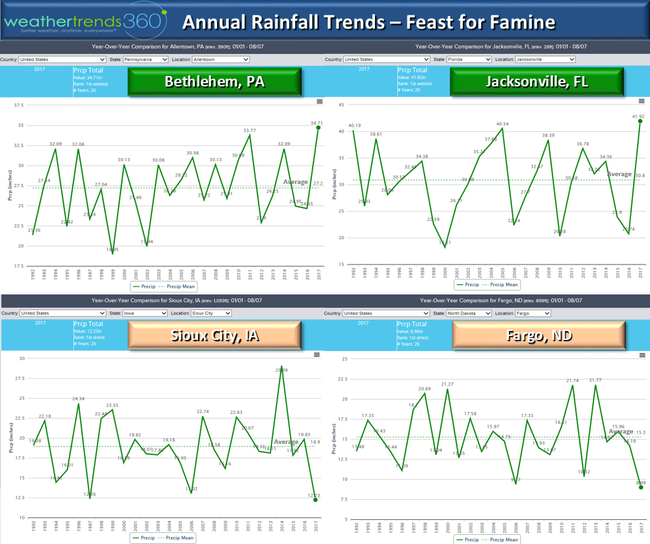
The next couple weeks show the U.S. pattern stuck in a rut with cool and wet conditions in the Eastern half of the U.S. while the Northwest bakes! But, the NW heat does look to make a move toward the Upper Plains next week so some relief in sight out West. It remains soggy in the South and East.

Speaking of heat, Death Valley CA set a global record hottest month ever recorded, at least since 1911. The Furnace Creek Station recorded a July average temperature of 107.4, keep in mind this meant max temps up over 122 on some days. Furnace Creek is quite a bit hotter than some other locations in Death Valley with higher elevation.
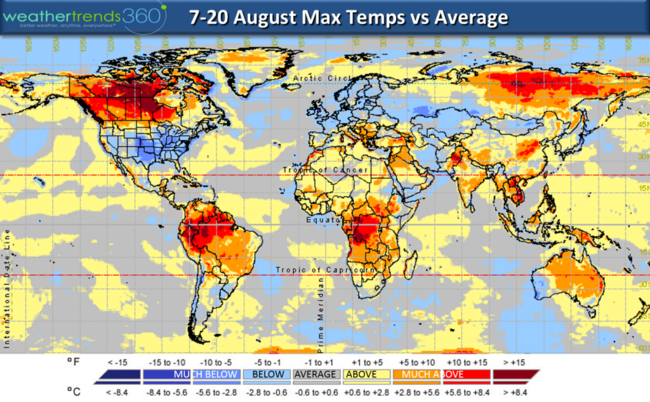
Globally the cools spots for the next couple weeks are the Central and Eastern U.S., Western Europe, Western Russia, and the North Pole regions. The hot spots are Canada (ironic how hot they are compared to the cooler anomalies in the U.S.), Brazil, Mediterranean/Middle East, India, Australia and China.
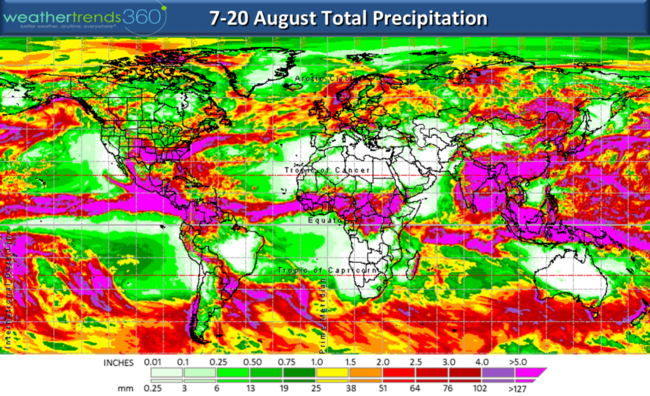
Rainfall remains heavy across the Southern U.S., the Tropics and Southeast Asia.
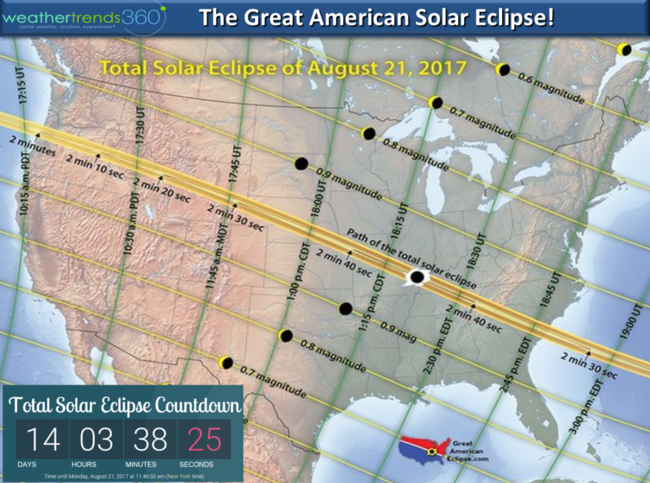
And we're only 14 days away from the Great American Eclipse!
Have a great week folks! - Capt Kirk out.
Another Tropical Storm ("Franklin") has flared up but again a short lived event in the Atlantic Basin. It is now a record shattering 4,306 days or 11 years 9.5 months since the last major hurricane hit the U.S. (Cat 3 Wilma 24 Oct 2005 hit Florida)...a 166+ year record drought.

The odds of this was 1 in 2000 according to hurricane experts at Colorado State University. We came close last year with Matthew but it was only a cat 1 at landfall. Fingers cross we go another year but we're bucking the odds and we are entering the peak of the hurricane season - now through late September. CLICK ON IMAGES FOR LARGER VIEW.
They could use some hurricane type rains in the Upper Midwest/Plains as soil moisture levels are very dry. Some areas in the Plains have less than 5% soil moisture which is having a negative impact on crops in the region. Here in the East almost saturated in spots with 35% to 40% soil moisture levels. The absolute max soil moisture level is around 50% in areas like rain forests.

This time last year we were having a severe drought in the Northeast and now this year we're on a record shattering pace for the wettest year on record. Bethlehem PA and Jacksonville FL are just a couple examples of YTD rainfall trends #1 wettest in decades while Sioux City IA and Fargo ND are having driest year in decades.

The next couple weeks show the U.S. pattern stuck in a rut with cool and wet conditions in the Eastern half of the U.S. while the Northwest bakes! But, the NW heat does look to make a move toward the Upper Plains next week so some relief in sight out West. It remains soggy in the South and East.

Speaking of heat, Death Valley CA set a global record hottest month ever recorded, at least since 1911. The Furnace Creek Station recorded a July average temperature of 107.4, keep in mind this meant max temps up over 122 on some days. Furnace Creek is quite a bit hotter than some other locations in Death Valley with higher elevation.

Globally the cools spots for the next couple weeks are the Central and Eastern U.S., Western Europe, Western Russia, and the North Pole regions. The hot spots are Canada (ironic how hot they are compared to the cooler anomalies in the U.S.), Brazil, Mediterranean/Middle East, India, Australia and China.

Rainfall remains heavy across the Southern U.S., the Tropics and Southeast Asia.

And we're only 14 days away from the Great American Eclipse!
Have a great week folks! - Capt Kirk out.